Factors Impacting Adolescents: Parental Separation Effects
VerifiedAdded on 2022/11/01
|31
|12042
|184
Report
AI Summary
This report delves into the multifaceted impact of parental separation on adolescents, exploring the factors that contribute to the challenges they face. The research begins with a refined research question focusing on the factors influencing adolescents' mental health and development in the context of parental separation. The methodology involves both primary and secondary research, including a review of journals, articles, case studies, and surveys. The report emphasizes the importance of ethical considerations, including informed consent and data privacy. The analysis covers the development of personal and social capabilities through the research process, as well as ethical understanding. The student outlines an action plan and a concept map to guide the research, including detailed stages for data collection, analysis, and report writing. Secondary source analysis is provided, focusing on an article from the Australian Institute of Family Studies, which highlights the perspectives of adolescents from separated families. The project aims to enhance analytical, research, and time management skills while providing valuable insights into the emotional and developmental impact of parental separation on adolescents.
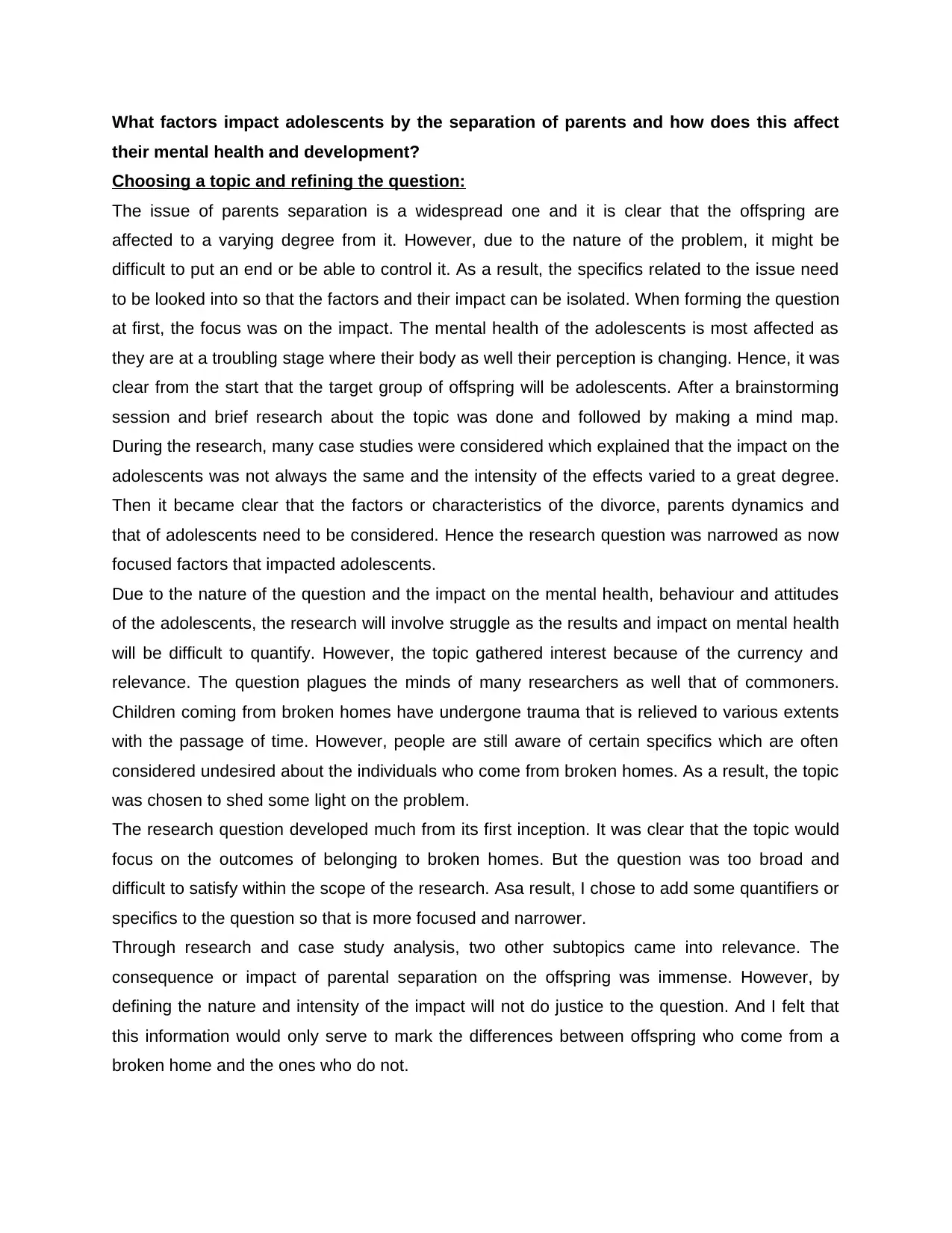
What factors impact adolescents by the separation of parents and how does this affect
their mental health and development?
Choosing a topic and refining the question:
The issue of parents separation is a widespread one and it is clear that the offspring are
affected to a varying degree from it. However, due to the nature of the problem, it might be
difficult to put an end or be able to control it. As a result, the specifics related to the issue need
to be looked into so that the factors and their impact can be isolated. When forming the question
at first, the focus was on the impact. The mental health of the adolescents is most affected as
they are at a troubling stage where their body as well their perception is changing. Hence, it was
clear from the start that the target group of offspring will be adolescents. After a brainstorming
session and brief research about the topic was done and followed by making a mind map.
During the research, many case studies were considered which explained that the impact on the
adolescents was not always the same and the intensity of the effects varied to a great degree.
Then it became clear that the factors or characteristics of the divorce, parents dynamics and
that of adolescents need to be considered. Hence the research question was narrowed as now
focused factors that impacted adolescents.
Due to the nature of the question and the impact on the mental health, behaviour and attitudes
of the adolescents, the research will involve struggle as the results and impact on mental health
will be difficult to quantify. However, the topic gathered interest because of the currency and
relevance. The question plagues the minds of many researchers as well that of commoners.
Children coming from broken homes have undergone trauma that is relieved to various extents
with the passage of time. However, people are still aware of certain specifics which are often
considered undesired about the individuals who come from broken homes. As a result, the topic
was chosen to shed some light on the problem.
The research question developed much from its first inception. It was clear that the topic would
focus on the outcomes of belonging to broken homes. But the question was too broad and
difficult to satisfy within the scope of the research. Asa result, I chose to add some quantifiers or
specifics to the question so that is more focused and narrower.
Through research and case study analysis, two other subtopics came into relevance. The
consequence or impact of parental separation on the offspring was immense. However, by
defining the nature and intensity of the impact will not do justice to the question. And I felt that
this information would only serve to mark the differences between offspring who come from a
broken home and the ones who do not.
their mental health and development?
Choosing a topic and refining the question:
The issue of parents separation is a widespread one and it is clear that the offspring are
affected to a varying degree from it. However, due to the nature of the problem, it might be
difficult to put an end or be able to control it. As a result, the specifics related to the issue need
to be looked into so that the factors and their impact can be isolated. When forming the question
at first, the focus was on the impact. The mental health of the adolescents is most affected as
they are at a troubling stage where their body as well their perception is changing. Hence, it was
clear from the start that the target group of offspring will be adolescents. After a brainstorming
session and brief research about the topic was done and followed by making a mind map.
During the research, many case studies were considered which explained that the impact on the
adolescents was not always the same and the intensity of the effects varied to a great degree.
Then it became clear that the factors or characteristics of the divorce, parents dynamics and
that of adolescents need to be considered. Hence the research question was narrowed as now
focused factors that impacted adolescents.
Due to the nature of the question and the impact on the mental health, behaviour and attitudes
of the adolescents, the research will involve struggle as the results and impact on mental health
will be difficult to quantify. However, the topic gathered interest because of the currency and
relevance. The question plagues the minds of many researchers as well that of commoners.
Children coming from broken homes have undergone trauma that is relieved to various extents
with the passage of time. However, people are still aware of certain specifics which are often
considered undesired about the individuals who come from broken homes. As a result, the topic
was chosen to shed some light on the problem.
The research question developed much from its first inception. It was clear that the topic would
focus on the outcomes of belonging to broken homes. But the question was too broad and
difficult to satisfy within the scope of the research. Asa result, I chose to add some quantifiers or
specifics to the question so that is more focused and narrower.
Through research and case study analysis, two other subtopics came into relevance. The
consequence or impact of parental separation on the offspring was immense. However, by
defining the nature and intensity of the impact will not do justice to the question. And I felt that
this information would only serve to mark the differences between offspring who come from a
broken home and the ones who do not.
Paraphrase This Document
Need a fresh take? Get an instant paraphrase of this document with our AI Paraphraser
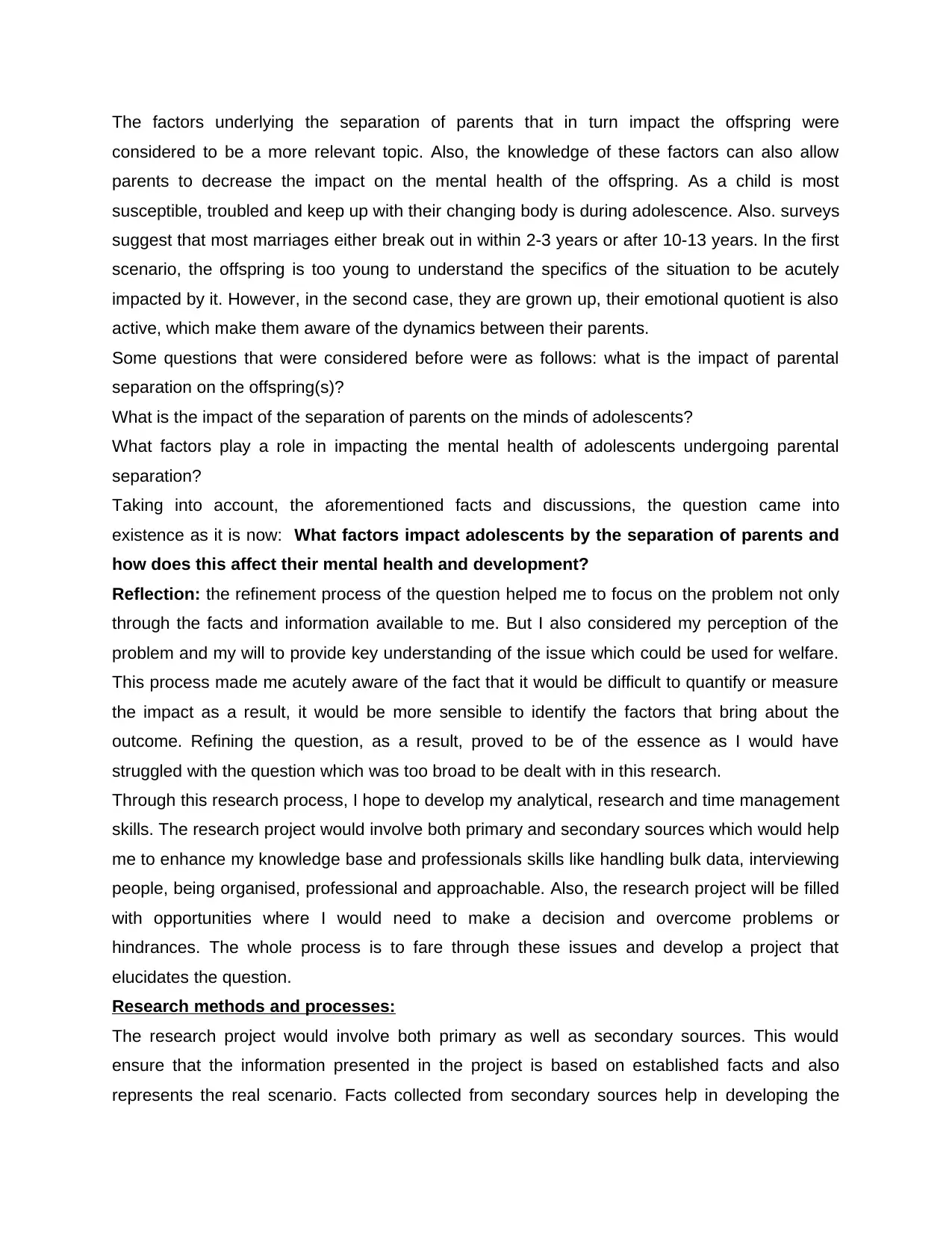
The factors underlying the separation of parents that in turn impact the offspring were
considered to be a more relevant topic. Also, the knowledge of these factors can also allow
parents to decrease the impact on the mental health of the offspring. As a child is most
susceptible, troubled and keep up with their changing body is during adolescence. Also. surveys
suggest that most marriages either break out in within 2-3 years or after 10-13 years. In the first
scenario, the offspring is too young to understand the specifics of the situation to be acutely
impacted by it. However, in the second case, they are grown up, their emotional quotient is also
active, which make them aware of the dynamics between their parents.
Some questions that were considered before were as follows: what is the impact of parental
separation on the offspring(s)?
What is the impact of the separation of parents on the minds of adolescents?
What factors play a role in impacting the mental health of adolescents undergoing parental
separation?
Taking into account, the aforementioned facts and discussions, the question came into
existence as it is now: What factors impact adolescents by the separation of parents and
how does this affect their mental health and development?
Reflection: the refinement process of the question helped me to focus on the problem not only
through the facts and information available to me. But I also considered my perception of the
problem and my will to provide key understanding of the issue which could be used for welfare.
This process made me acutely aware of the fact that it would be difficult to quantify or measure
the impact as a result, it would be more sensible to identify the factors that bring about the
outcome. Refining the question, as a result, proved to be of the essence as I would have
struggled with the question which was too broad to be dealt with in this research.
Through this research process, I hope to develop my analytical, research and time management
skills. The research project would involve both primary and secondary sources which would help
me to enhance my knowledge base and professionals skills like handling bulk data, interviewing
people, being organised, professional and approachable. Also, the research project will be filled
with opportunities where I would need to make a decision and overcome problems or
hindrances. The whole process is to fare through these issues and develop a project that
elucidates the question.
Research methods and processes:
The research project would involve both primary as well as secondary sources. This would
ensure that the information presented in the project is based on established facts and also
represents the real scenario. Facts collected from secondary sources help in developing the
considered to be a more relevant topic. Also, the knowledge of these factors can also allow
parents to decrease the impact on the mental health of the offspring. As a child is most
susceptible, troubled and keep up with their changing body is during adolescence. Also. surveys
suggest that most marriages either break out in within 2-3 years or after 10-13 years. In the first
scenario, the offspring is too young to understand the specifics of the situation to be acutely
impacted by it. However, in the second case, they are grown up, their emotional quotient is also
active, which make them aware of the dynamics between their parents.
Some questions that were considered before were as follows: what is the impact of parental
separation on the offspring(s)?
What is the impact of the separation of parents on the minds of adolescents?
What factors play a role in impacting the mental health of adolescents undergoing parental
separation?
Taking into account, the aforementioned facts and discussions, the question came into
existence as it is now: What factors impact adolescents by the separation of parents and
how does this affect their mental health and development?
Reflection: the refinement process of the question helped me to focus on the problem not only
through the facts and information available to me. But I also considered my perception of the
problem and my will to provide key understanding of the issue which could be used for welfare.
This process made me acutely aware of the fact that it would be difficult to quantify or measure
the impact as a result, it would be more sensible to identify the factors that bring about the
outcome. Refining the question, as a result, proved to be of the essence as I would have
struggled with the question which was too broad to be dealt with in this research.
Through this research process, I hope to develop my analytical, research and time management
skills. The research project would involve both primary and secondary sources which would help
me to enhance my knowledge base and professionals skills like handling bulk data, interviewing
people, being organised, professional and approachable. Also, the research project will be filled
with opportunities where I would need to make a decision and overcome problems or
hindrances. The whole process is to fare through these issues and develop a project that
elucidates the question.
Research methods and processes:
The research project would involve both primary as well as secondary sources. This would
ensure that the information presented in the project is based on established facts and also
represents the real scenario. Facts collected from secondary sources help in developing the
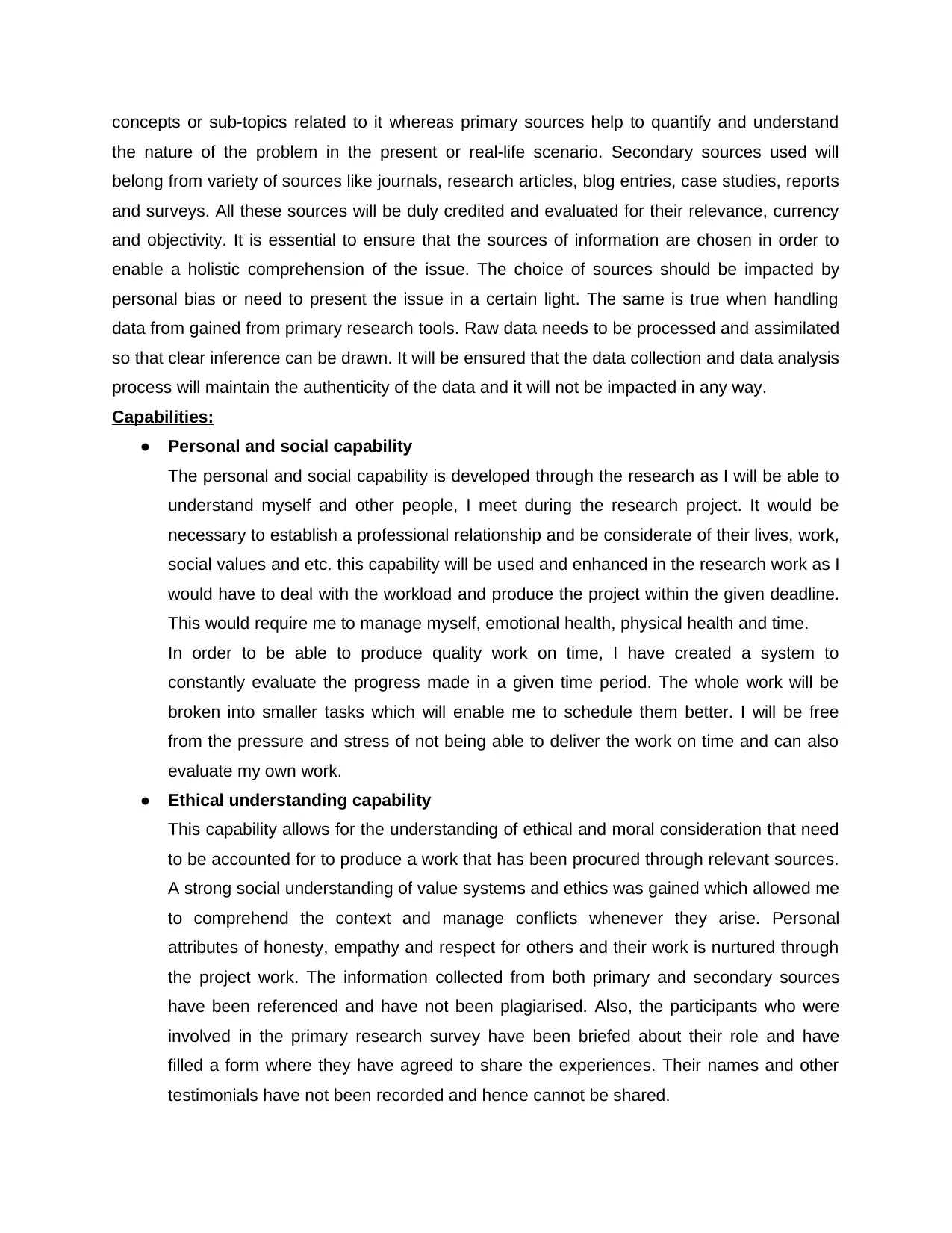
concepts or sub-topics related to it whereas primary sources help to quantify and understand
the nature of the problem in the present or real-life scenario. Secondary sources used will
belong from variety of sources like journals, research articles, blog entries, case studies, reports
and surveys. All these sources will be duly credited and evaluated for their relevance, currency
and objectivity. It is essential to ensure that the sources of information are chosen in order to
enable a holistic comprehension of the issue. The choice of sources should be impacted by
personal bias or need to present the issue in a certain light. The same is true when handling
data from gained from primary research tools. Raw data needs to be processed and assimilated
so that clear inference can be drawn. It will be ensured that the data collection and data analysis
process will maintain the authenticity of the data and it will not be impacted in any way.
Capabilities:
● Personal and social capability
The personal and social capability is developed through the research as I will be able to
understand myself and other people, I meet during the research project. It would be
necessary to establish a professional relationship and be considerate of their lives, work,
social values and etc. this capability will be used and enhanced in the research work as I
would have to deal with the workload and produce the project within the given deadline.
This would require me to manage myself, emotional health, physical health and time.
In order to be able to produce quality work on time, I have created a system to
constantly evaluate the progress made in a given time period. The whole work will be
broken into smaller tasks which will enable me to schedule them better. I will be free
from the pressure and stress of not being able to deliver the work on time and can also
evaluate my own work.
● Ethical understanding capability
This capability allows for the understanding of ethical and moral consideration that need
to be accounted for to produce a work that has been procured through relevant sources.
A strong social understanding of value systems and ethics was gained which allowed me
to comprehend the context and manage conflicts whenever they arise. Personal
attributes of honesty, empathy and respect for others and their work is nurtured through
the project work. The information collected from both primary and secondary sources
have been referenced and have not been plagiarised. Also, the participants who were
involved in the primary research survey have been briefed about their role and have
filled a form where they have agreed to share the experiences. Their names and other
testimonials have not been recorded and hence cannot be shared.
the nature of the problem in the present or real-life scenario. Secondary sources used will
belong from variety of sources like journals, research articles, blog entries, case studies, reports
and surveys. All these sources will be duly credited and evaluated for their relevance, currency
and objectivity. It is essential to ensure that the sources of information are chosen in order to
enable a holistic comprehension of the issue. The choice of sources should be impacted by
personal bias or need to present the issue in a certain light. The same is true when handling
data from gained from primary research tools. Raw data needs to be processed and assimilated
so that clear inference can be drawn. It will be ensured that the data collection and data analysis
process will maintain the authenticity of the data and it will not be impacted in any way.
Capabilities:
● Personal and social capability
The personal and social capability is developed through the research as I will be able to
understand myself and other people, I meet during the research project. It would be
necessary to establish a professional relationship and be considerate of their lives, work,
social values and etc. this capability will be used and enhanced in the research work as I
would have to deal with the workload and produce the project within the given deadline.
This would require me to manage myself, emotional health, physical health and time.
In order to be able to produce quality work on time, I have created a system to
constantly evaluate the progress made in a given time period. The whole work will be
broken into smaller tasks which will enable me to schedule them better. I will be free
from the pressure and stress of not being able to deliver the work on time and can also
evaluate my own work.
● Ethical understanding capability
This capability allows for the understanding of ethical and moral consideration that need
to be accounted for to produce a work that has been procured through relevant sources.
A strong social understanding of value systems and ethics was gained which allowed me
to comprehend the context and manage conflicts whenever they arise. Personal
attributes of honesty, empathy and respect for others and their work is nurtured through
the project work. The information collected from both primary and secondary sources
have been referenced and have not been plagiarised. Also, the participants who were
involved in the primary research survey have been briefed about their role and have
filled a form where they have agreed to share the experiences. Their names and other
testimonials have not been recorded and hence cannot be shared.
⊘ This is a preview!⊘
Do you want full access?
Subscribe today to unlock all pages.

Trusted by 1+ million students worldwide

Ethical Considerations and time management:
The ethical consideration were all fulfilled and the research is a piece of genuine, moral and
relevant literature that has been collected from both primary and secondary sources. Both these
sources have been acknowledged and the personal information of the participants of the survey
have not been collected and cannot be shared. In order to be on time, grant chart was made
and the project tasks were divided accordingly. This provided an informed perspective about the
progress of the work and allowed me to take planned breaks in order to relieve the stress from
the work.
Main activities
and stages
Day 1 to
3
Day 4 to
6
Day 7 to
10
Day 11
and 12
Day 13
to 15
Day 16-
19
Day 20
Selection of
the topic
✓
Collection of
data
✓
Planning the
proper layout
✓
Reviewing
literature
✓
Development
of the
research plan
✓ ✓
Selecting a
research
technique
✓
Gathering
primary data
✓
Data analysis ✓
Interpretation
of findings
✓
Conclusion
preparation
✓
Project rough
overdraft
✓
The ethical consideration were all fulfilled and the research is a piece of genuine, moral and
relevant literature that has been collected from both primary and secondary sources. Both these
sources have been acknowledged and the personal information of the participants of the survey
have not been collected and cannot be shared. In order to be on time, grant chart was made
and the project tasks were divided accordingly. This provided an informed perspective about the
progress of the work and allowed me to take planned breaks in order to relieve the stress from
the work.
Main activities
and stages
Day 1 to
3
Day 4 to
6
Day 7 to
10
Day 11
and 12
Day 13
to 15
Day 16-
19
Day 20
Selection of
the topic
✓
Collection of
data
✓
Planning the
proper layout
✓
Reviewing
literature
✓
Development
of the
research plan
✓ ✓
Selecting a
research
technique
✓
Gathering
primary data
✓
Data analysis ✓
Interpretation
of findings
✓
Conclusion
preparation
✓
Project rough
overdraft
✓
Paraphrase This Document
Need a fresh take? Get an instant paraphrase of this document with our AI Paraphraser
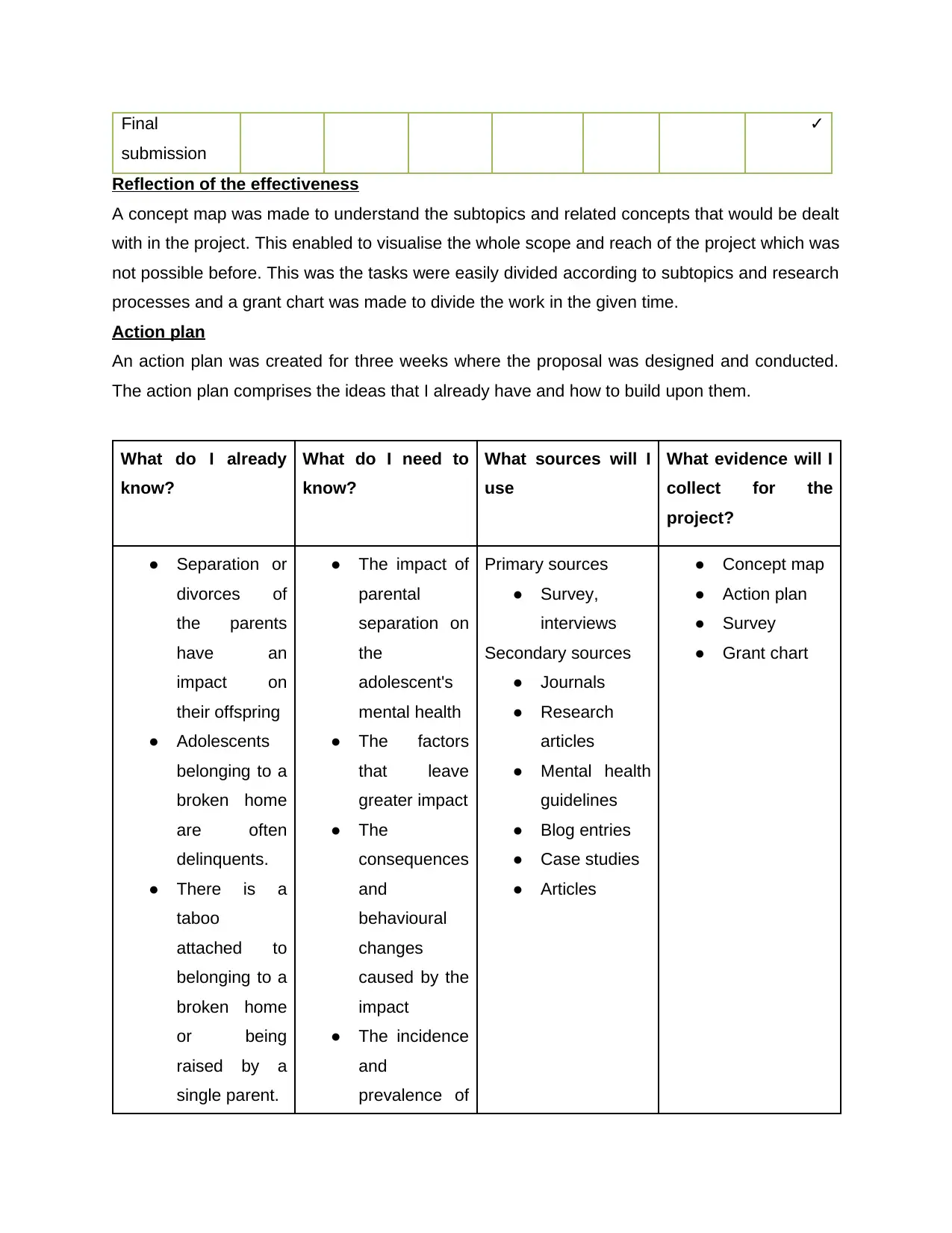
Final
submission
✓
Reflection of the effectiveness
A concept map was made to understand the subtopics and related concepts that would be dealt
with in the project. This enabled to visualise the whole scope and reach of the project which was
not possible before. This was the tasks were easily divided according to subtopics and research
processes and a grant chart was made to divide the work in the given time.
Action plan
An action plan was created for three weeks where the proposal was designed and conducted.
The action plan comprises the ideas that I already have and how to build upon them.
What do I already
know?
What do I need to
know?
What sources will I
use
What evidence will I
collect for the
project?
● Separation or
divorces of
the parents
have an
impact on
their offspring
● Adolescents
belonging to a
broken home
are often
delinquents.
● There is a
taboo
attached to
belonging to a
broken home
or being
raised by a
single parent.
● The impact of
parental
separation on
the
adolescent's
mental health
● The factors
that leave
greater impact
● The
consequences
and
behavioural
changes
caused by the
impact
● The incidence
and
prevalence of
Primary sources
● Survey,
interviews
Secondary sources
● Journals
● Research
articles
● Mental health
guidelines
● Blog entries
● Case studies
● Articles
● Concept map
● Action plan
● Survey
● Grant chart
submission
✓
Reflection of the effectiveness
A concept map was made to understand the subtopics and related concepts that would be dealt
with in the project. This enabled to visualise the whole scope and reach of the project which was
not possible before. This was the tasks were easily divided according to subtopics and research
processes and a grant chart was made to divide the work in the given time.
Action plan
An action plan was created for three weeks where the proposal was designed and conducted.
The action plan comprises the ideas that I already have and how to build upon them.
What do I already
know?
What do I need to
know?
What sources will I
use
What evidence will I
collect for the
project?
● Separation or
divorces of
the parents
have an
impact on
their offspring
● Adolescents
belonging to a
broken home
are often
delinquents.
● There is a
taboo
attached to
belonging to a
broken home
or being
raised by a
single parent.
● The impact of
parental
separation on
the
adolescent's
mental health
● The factors
that leave
greater impact
● The
consequences
and
behavioural
changes
caused by the
impact
● The incidence
and
prevalence of
Primary sources
● Survey,
interviews
Secondary sources
● Journals
● Research
articles
● Mental health
guidelines
● Blog entries
● Case studies
● Articles
● Concept map
● Action plan
● Survey
● Grant chart
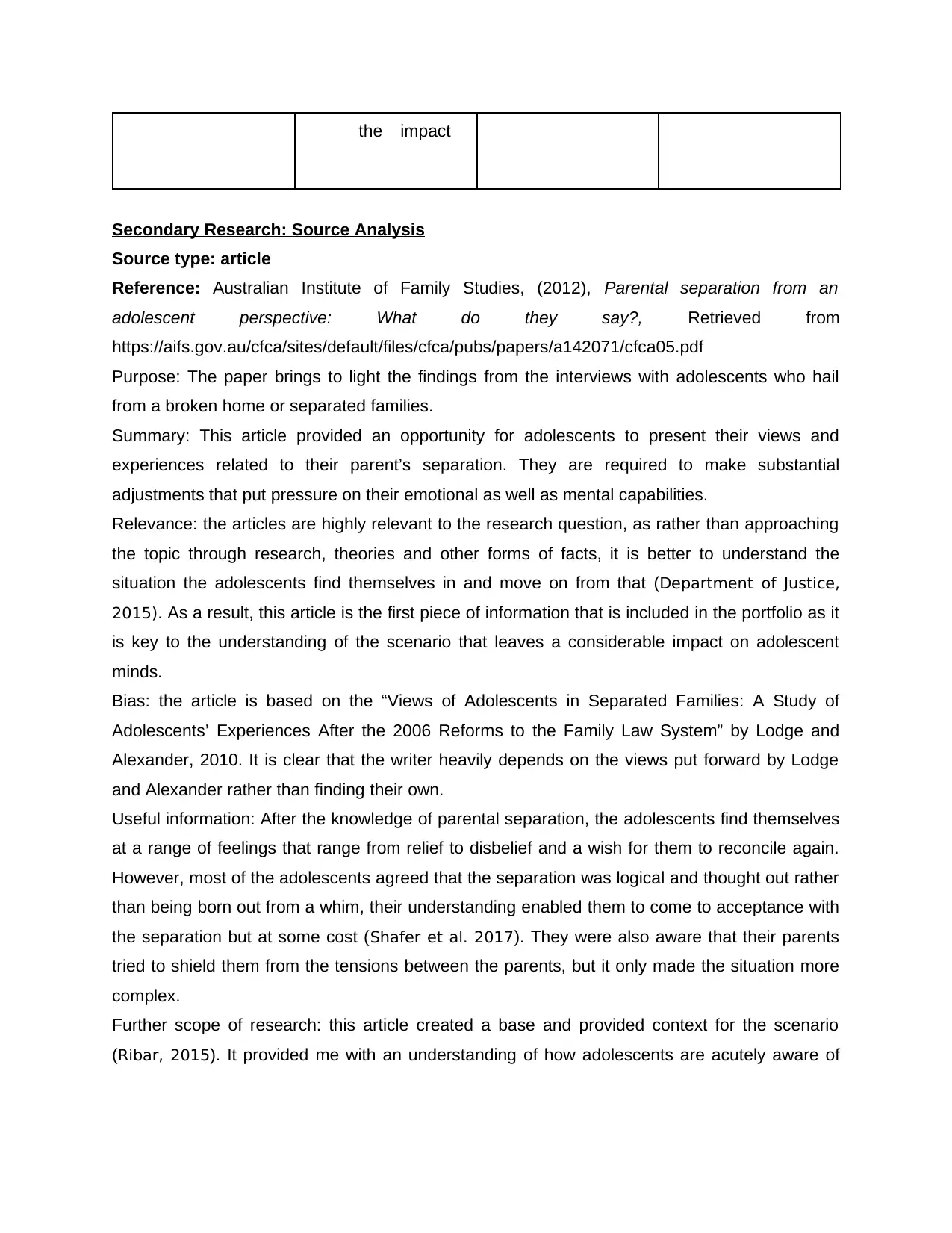
the impact
Secondary Research: Source Analysis
Source type: article
Reference: Australian Institute of Family Studies, (2012), Parental separation from an
adolescent perspective: What do they say?, Retrieved from
https://aifs.gov.au/cfca/sites/default/files/cfca/pubs/papers/a142071/cfca05.pdf
Purpose: The paper brings to light the findings from the interviews with adolescents who hail
from a broken home or separated families.
Summary: This article provided an opportunity for adolescents to present their views and
experiences related to their parent’s separation. They are required to make substantial
adjustments that put pressure on their emotional as well as mental capabilities.
Relevance: the articles are highly relevant to the research question, as rather than approaching
the topic through research, theories and other forms of facts, it is better to understand the
situation the adolescents find themselves in and move on from that (Department of Justice,
2015). As a result, this article is the first piece of information that is included in the portfolio as it
is key to the understanding of the scenario that leaves a considerable impact on adolescent
minds.
Bias: the article is based on the “Views of Adolescents in Separated Families: A Study of
Adolescents’ Experiences After the 2006 Reforms to the Family Law System” by Lodge and
Alexander, 2010. It is clear that the writer heavily depends on the views put forward by Lodge
and Alexander rather than finding their own.
Useful information: After the knowledge of parental separation, the adolescents find themselves
at a range of feelings that range from relief to disbelief and a wish for them to reconcile again.
However, most of the adolescents agreed that the separation was logical and thought out rather
than being born out from a whim, their understanding enabled them to come to acceptance with
the separation but at some cost (Shafer et al. 2017). They were also aware that their parents
tried to shield them from the tensions between the parents, but it only made the situation more
complex.
Further scope of research: this article created a base and provided context for the scenario
(Ribar, 2015). It provided me with an understanding of how adolescents are acutely aware of
Secondary Research: Source Analysis
Source type: article
Reference: Australian Institute of Family Studies, (2012), Parental separation from an
adolescent perspective: What do they say?, Retrieved from
https://aifs.gov.au/cfca/sites/default/files/cfca/pubs/papers/a142071/cfca05.pdf
Purpose: The paper brings to light the findings from the interviews with adolescents who hail
from a broken home or separated families.
Summary: This article provided an opportunity for adolescents to present their views and
experiences related to their parent’s separation. They are required to make substantial
adjustments that put pressure on their emotional as well as mental capabilities.
Relevance: the articles are highly relevant to the research question, as rather than approaching
the topic through research, theories and other forms of facts, it is better to understand the
situation the adolescents find themselves in and move on from that (Department of Justice,
2015). As a result, this article is the first piece of information that is included in the portfolio as it
is key to the understanding of the scenario that leaves a considerable impact on adolescent
minds.
Bias: the article is based on the “Views of Adolescents in Separated Families: A Study of
Adolescents’ Experiences After the 2006 Reforms to the Family Law System” by Lodge and
Alexander, 2010. It is clear that the writer heavily depends on the views put forward by Lodge
and Alexander rather than finding their own.
Useful information: After the knowledge of parental separation, the adolescents find themselves
at a range of feelings that range from relief to disbelief and a wish for them to reconcile again.
However, most of the adolescents agreed that the separation was logical and thought out rather
than being born out from a whim, their understanding enabled them to come to acceptance with
the separation but at some cost (Shafer et al. 2017). They were also aware that their parents
tried to shield them from the tensions between the parents, but it only made the situation more
complex.
Further scope of research: this article created a base and provided context for the scenario
(Ribar, 2015). It provided me with an understanding of how adolescents are acutely aware of
⊘ This is a preview!⊘
Do you want full access?
Subscribe today to unlock all pages.

Trusted by 1+ million students worldwide
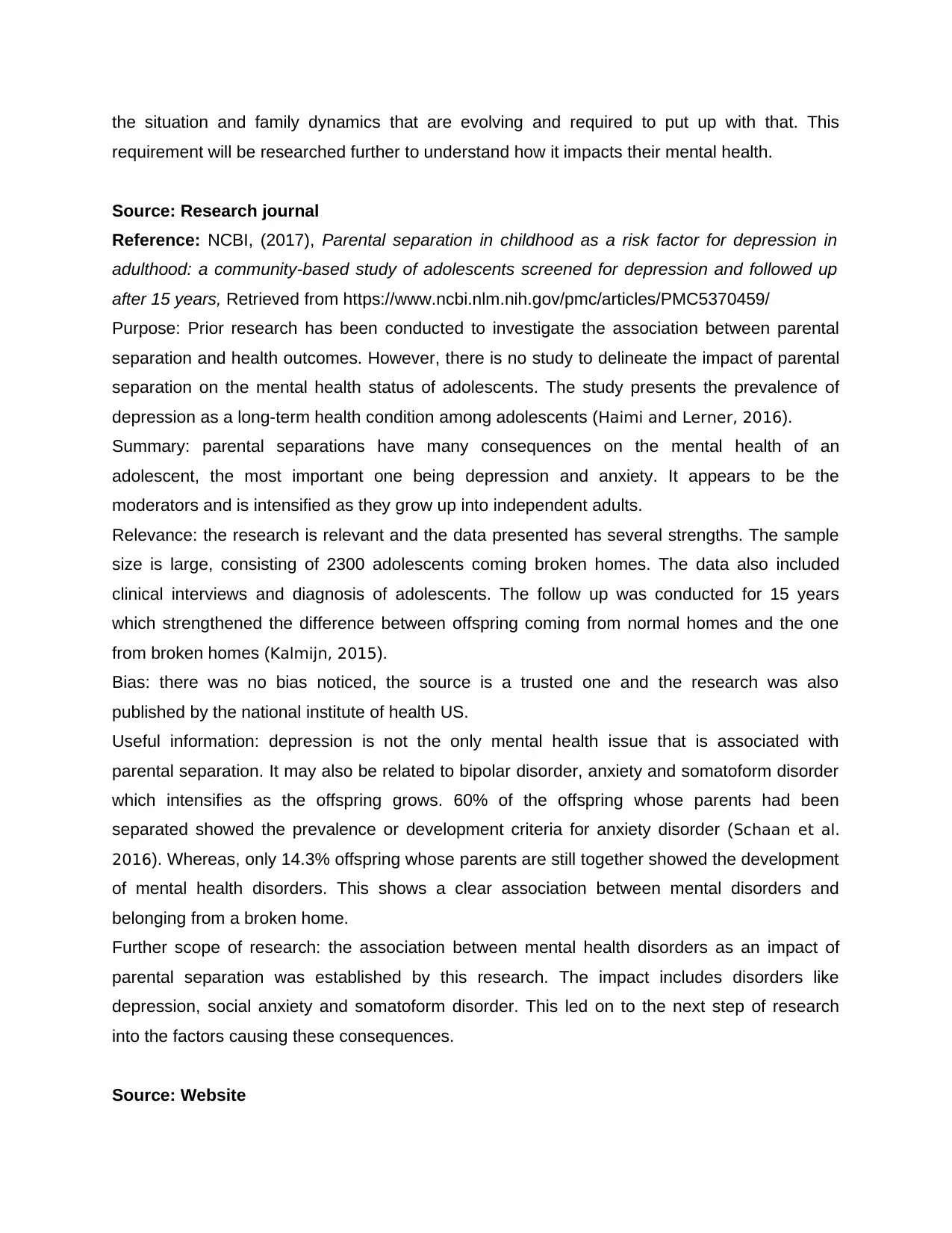
the situation and family dynamics that are evolving and required to put up with that. This
requirement will be researched further to understand how it impacts their mental health.
Source: Research journal
Reference: NCBI, (2017), Parental separation in childhood as a risk factor for depression in
adulthood: a community-based study of adolescents screened for depression and followed up
after 15 years, Retrieved from https://www.ncbi.nlm.nih.gov/pmc/articles/PMC5370459/
Purpose: Prior research has been conducted to investigate the association between parental
separation and health outcomes. However, there is no study to delineate the impact of parental
separation on the mental health status of adolescents. The study presents the prevalence of
depression as a long-term health condition among adolescents (Haimi and Lerner, 2016).
Summary: parental separations have many consequences on the mental health of an
adolescent, the most important one being depression and anxiety. It appears to be the
moderators and is intensified as they grow up into independent adults.
Relevance: the research is relevant and the data presented has several strengths. The sample
size is large, consisting of 2300 adolescents coming broken homes. The data also included
clinical interviews and diagnosis of adolescents. The follow up was conducted for 15 years
which strengthened the difference between offspring coming from normal homes and the one
from broken homes (Kalmijn, 2015).
Bias: there was no bias noticed, the source is a trusted one and the research was also
published by the national institute of health US.
Useful information: depression is not the only mental health issue that is associated with
parental separation. It may also be related to bipolar disorder, anxiety and somatoform disorder
which intensifies as the offspring grows. 60% of the offspring whose parents had been
separated showed the prevalence or development criteria for anxiety disorder (Schaan et al.
2016). Whereas, only 14.3% offspring whose parents are still together showed the development
of mental health disorders. This shows a clear association between mental disorders and
belonging from a broken home.
Further scope of research: the association between mental health disorders as an impact of
parental separation was established by this research. The impact includes disorders like
depression, social anxiety and somatoform disorder. This led on to the next step of research
into the factors causing these consequences.
Source: Website
requirement will be researched further to understand how it impacts their mental health.
Source: Research journal
Reference: NCBI, (2017), Parental separation in childhood as a risk factor for depression in
adulthood: a community-based study of adolescents screened for depression and followed up
after 15 years, Retrieved from https://www.ncbi.nlm.nih.gov/pmc/articles/PMC5370459/
Purpose: Prior research has been conducted to investigate the association between parental
separation and health outcomes. However, there is no study to delineate the impact of parental
separation on the mental health status of adolescents. The study presents the prevalence of
depression as a long-term health condition among adolescents (Haimi and Lerner, 2016).
Summary: parental separations have many consequences on the mental health of an
adolescent, the most important one being depression and anxiety. It appears to be the
moderators and is intensified as they grow up into independent adults.
Relevance: the research is relevant and the data presented has several strengths. The sample
size is large, consisting of 2300 adolescents coming broken homes. The data also included
clinical interviews and diagnosis of adolescents. The follow up was conducted for 15 years
which strengthened the difference between offspring coming from normal homes and the one
from broken homes (Kalmijn, 2015).
Bias: there was no bias noticed, the source is a trusted one and the research was also
published by the national institute of health US.
Useful information: depression is not the only mental health issue that is associated with
parental separation. It may also be related to bipolar disorder, anxiety and somatoform disorder
which intensifies as the offspring grows. 60% of the offspring whose parents had been
separated showed the prevalence or development criteria for anxiety disorder (Schaan et al.
2016). Whereas, only 14.3% offspring whose parents are still together showed the development
of mental health disorders. This shows a clear association between mental disorders and
belonging from a broken home.
Further scope of research: the association between mental health disorders as an impact of
parental separation was established by this research. The impact includes disorders like
depression, social anxiety and somatoform disorder. This led on to the next step of research
into the factors causing these consequences.
Source: Website
Paraphrase This Document
Need a fresh take? Get an instant paraphrase of this document with our AI Paraphraser
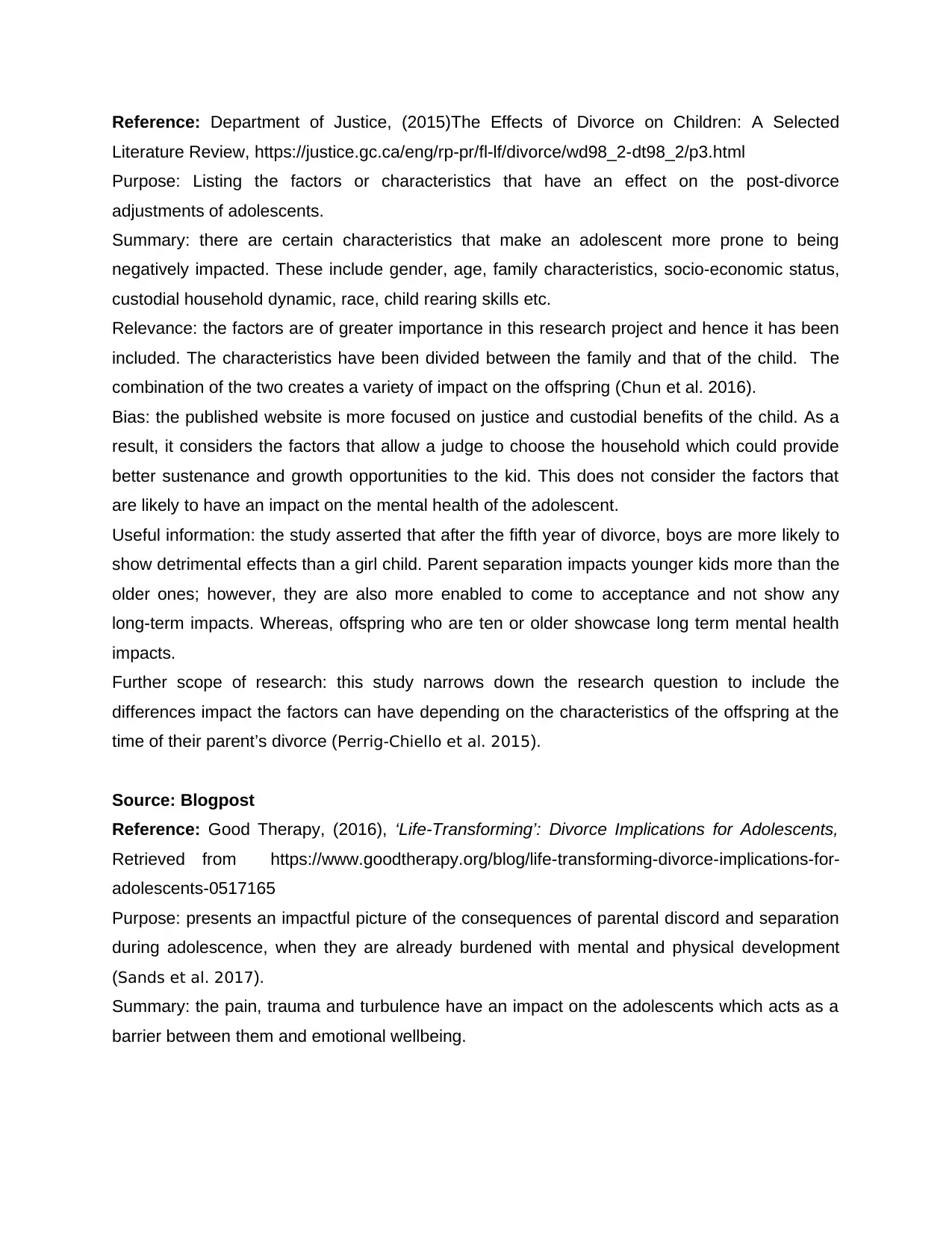
Reference: Department of Justice, (2015)The Effects of Divorce on Children: A Selected
Literature Review, https://justice.gc.ca/eng/rp-pr/fl-lf/divorce/wd98_2-dt98_2/p3.html
Purpose: Listing the factors or characteristics that have an effect on the post-divorce
adjustments of adolescents.
Summary: there are certain characteristics that make an adolescent more prone to being
negatively impacted. These include gender, age, family characteristics, socio-economic status,
custodial household dynamic, race, child rearing skills etc.
Relevance: the factors are of greater importance in this research project and hence it has been
included. The characteristics have been divided between the family and that of the child. The
combination of the two creates a variety of impact on the offspring (Chun et al. 2016).
Bias: the published website is more focused on justice and custodial benefits of the child. As a
result, it considers the factors that allow a judge to choose the household which could provide
better sustenance and growth opportunities to the kid. This does not consider the factors that
are likely to have an impact on the mental health of the adolescent.
Useful information: the study asserted that after the fifth year of divorce, boys are more likely to
show detrimental effects than a girl child. Parent separation impacts younger kids more than the
older ones; however, they are also more enabled to come to acceptance and not show any
long-term impacts. Whereas, offspring who are ten or older showcase long term mental health
impacts.
Further scope of research: this study narrows down the research question to include the
differences impact the factors can have depending on the characteristics of the offspring at the
time of their parent’s divorce (Perrig-Chiello et al. 2015).
Source: Blogpost
Reference: Good Therapy, (2016), ‘Life-Transforming’: Divorce Implications for Adolescents,
Retrieved from https://www.goodtherapy.org/blog/life-transforming-divorce-implications-for-
adolescents-0517165
Purpose: presents an impactful picture of the consequences of parental discord and separation
during adolescence, when they are already burdened with mental and physical development
(Sands et al. 2017).
Summary: the pain, trauma and turbulence have an impact on the adolescents which acts as a
barrier between them and emotional wellbeing.
Literature Review, https://justice.gc.ca/eng/rp-pr/fl-lf/divorce/wd98_2-dt98_2/p3.html
Purpose: Listing the factors or characteristics that have an effect on the post-divorce
adjustments of adolescents.
Summary: there are certain characteristics that make an adolescent more prone to being
negatively impacted. These include gender, age, family characteristics, socio-economic status,
custodial household dynamic, race, child rearing skills etc.
Relevance: the factors are of greater importance in this research project and hence it has been
included. The characteristics have been divided between the family and that of the child. The
combination of the two creates a variety of impact on the offspring (Chun et al. 2016).
Bias: the published website is more focused on justice and custodial benefits of the child. As a
result, it considers the factors that allow a judge to choose the household which could provide
better sustenance and growth opportunities to the kid. This does not consider the factors that
are likely to have an impact on the mental health of the adolescent.
Useful information: the study asserted that after the fifth year of divorce, boys are more likely to
show detrimental effects than a girl child. Parent separation impacts younger kids more than the
older ones; however, they are also more enabled to come to acceptance and not show any
long-term impacts. Whereas, offspring who are ten or older showcase long term mental health
impacts.
Further scope of research: this study narrows down the research question to include the
differences impact the factors can have depending on the characteristics of the offspring at the
time of their parent’s divorce (Perrig-Chiello et al. 2015).
Source: Blogpost
Reference: Good Therapy, (2016), ‘Life-Transforming’: Divorce Implications for Adolescents,
Retrieved from https://www.goodtherapy.org/blog/life-transforming-divorce-implications-for-
adolescents-0517165
Purpose: presents an impactful picture of the consequences of parental discord and separation
during adolescence, when they are already burdened with mental and physical development
(Sands et al. 2017).
Summary: the pain, trauma and turbulence have an impact on the adolescents which acts as a
barrier between them and emotional wellbeing.
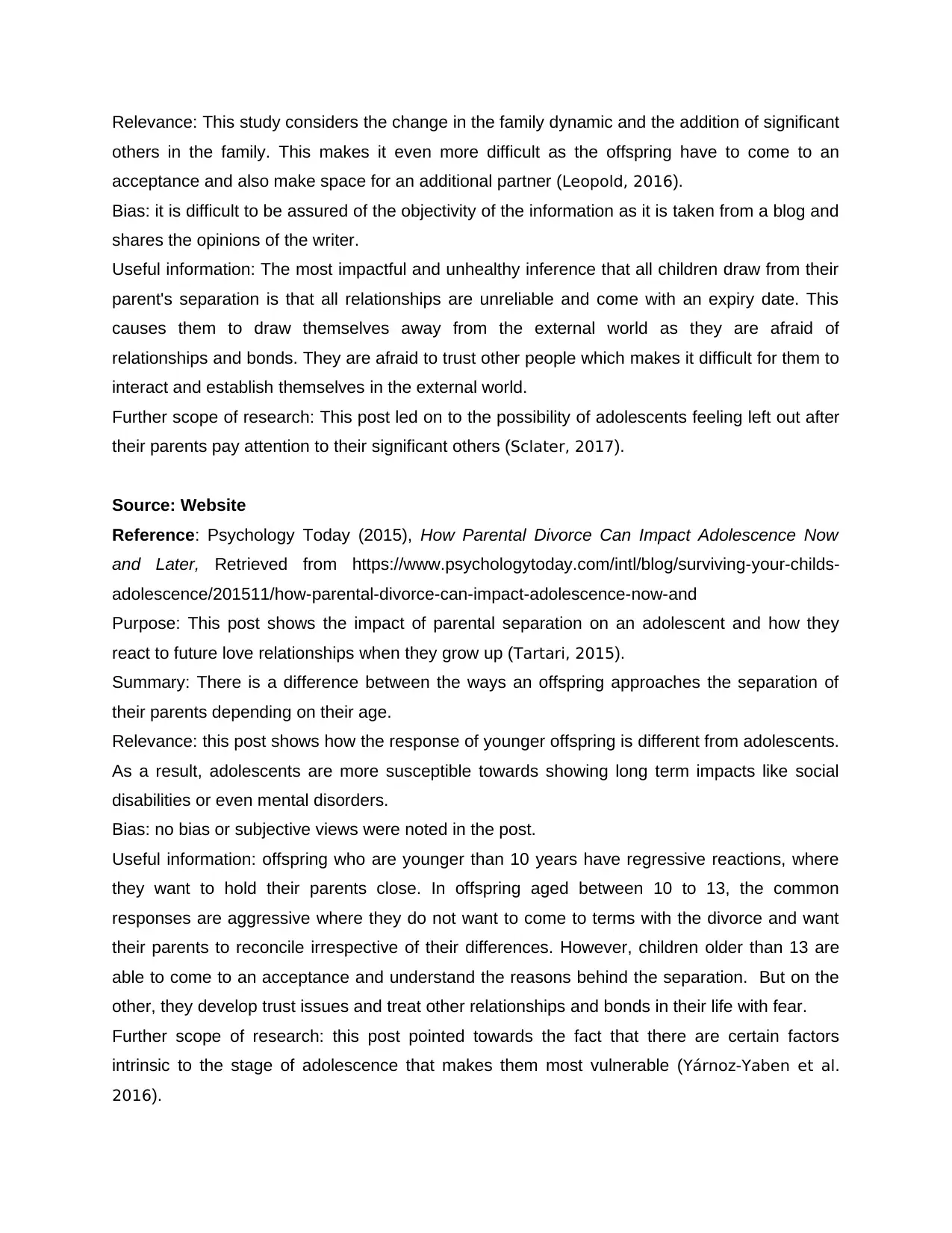
Relevance: This study considers the change in the family dynamic and the addition of significant
others in the family. This makes it even more difficult as the offspring have to come to an
acceptance and also make space for an additional partner (Leopold, 2016).
Bias: it is difficult to be assured of the objectivity of the information as it is taken from a blog and
shares the opinions of the writer.
Useful information: The most impactful and unhealthy inference that all children draw from their
parent's separation is that all relationships are unreliable and come with an expiry date. This
causes them to draw themselves away from the external world as they are afraid of
relationships and bonds. They are afraid to trust other people which makes it difficult for them to
interact and establish themselves in the external world.
Further scope of research: This post led on to the possibility of adolescents feeling left out after
their parents pay attention to their significant others (Sclater, 2017).
Source: Website
Reference: Psychology Today (2015), How Parental Divorce Can Impact Adolescence Now
and Later, Retrieved from https://www.psychologytoday.com/intl/blog/surviving-your-childs-
adolescence/201511/how-parental-divorce-can-impact-adolescence-now-and
Purpose: This post shows the impact of parental separation on an adolescent and how they
react to future love relationships when they grow up (Tartari, 2015).
Summary: There is a difference between the ways an offspring approaches the separation of
their parents depending on their age.
Relevance: this post shows how the response of younger offspring is different from adolescents.
As a result, adolescents are more susceptible towards showing long term impacts like social
disabilities or even mental disorders.
Bias: no bias or subjective views were noted in the post.
Useful information: offspring who are younger than 10 years have regressive reactions, where
they want to hold their parents close. In offspring aged between 10 to 13, the common
responses are aggressive where they do not want to come to terms with the divorce and want
their parents to reconcile irrespective of their differences. However, children older than 13 are
able to come to an acceptance and understand the reasons behind the separation. But on the
other, they develop trust issues and treat other relationships and bonds in their life with fear.
Further scope of research: this post pointed towards the fact that there are certain factors
intrinsic to the stage of adolescence that makes them most vulnerable (Yárnoz-Yaben et al.
2016).
others in the family. This makes it even more difficult as the offspring have to come to an
acceptance and also make space for an additional partner (Leopold, 2016).
Bias: it is difficult to be assured of the objectivity of the information as it is taken from a blog and
shares the opinions of the writer.
Useful information: The most impactful and unhealthy inference that all children draw from their
parent's separation is that all relationships are unreliable and come with an expiry date. This
causes them to draw themselves away from the external world as they are afraid of
relationships and bonds. They are afraid to trust other people which makes it difficult for them to
interact and establish themselves in the external world.
Further scope of research: This post led on to the possibility of adolescents feeling left out after
their parents pay attention to their significant others (Sclater, 2017).
Source: Website
Reference: Psychology Today (2015), How Parental Divorce Can Impact Adolescence Now
and Later, Retrieved from https://www.psychologytoday.com/intl/blog/surviving-your-childs-
adolescence/201511/how-parental-divorce-can-impact-adolescence-now-and
Purpose: This post shows the impact of parental separation on an adolescent and how they
react to future love relationships when they grow up (Tartari, 2015).
Summary: There is a difference between the ways an offspring approaches the separation of
their parents depending on their age.
Relevance: this post shows how the response of younger offspring is different from adolescents.
As a result, adolescents are more susceptible towards showing long term impacts like social
disabilities or even mental disorders.
Bias: no bias or subjective views were noted in the post.
Useful information: offspring who are younger than 10 years have regressive reactions, where
they want to hold their parents close. In offspring aged between 10 to 13, the common
responses are aggressive where they do not want to come to terms with the divorce and want
their parents to reconcile irrespective of their differences. However, children older than 13 are
able to come to an acceptance and understand the reasons behind the separation. But on the
other, they develop trust issues and treat other relationships and bonds in their life with fear.
Further scope of research: this post pointed towards the fact that there are certain factors
intrinsic to the stage of adolescence that makes them most vulnerable (Yárnoz-Yaben et al.
2016).
⊘ This is a preview!⊘
Do you want full access?
Subscribe today to unlock all pages.

Trusted by 1+ million students worldwide
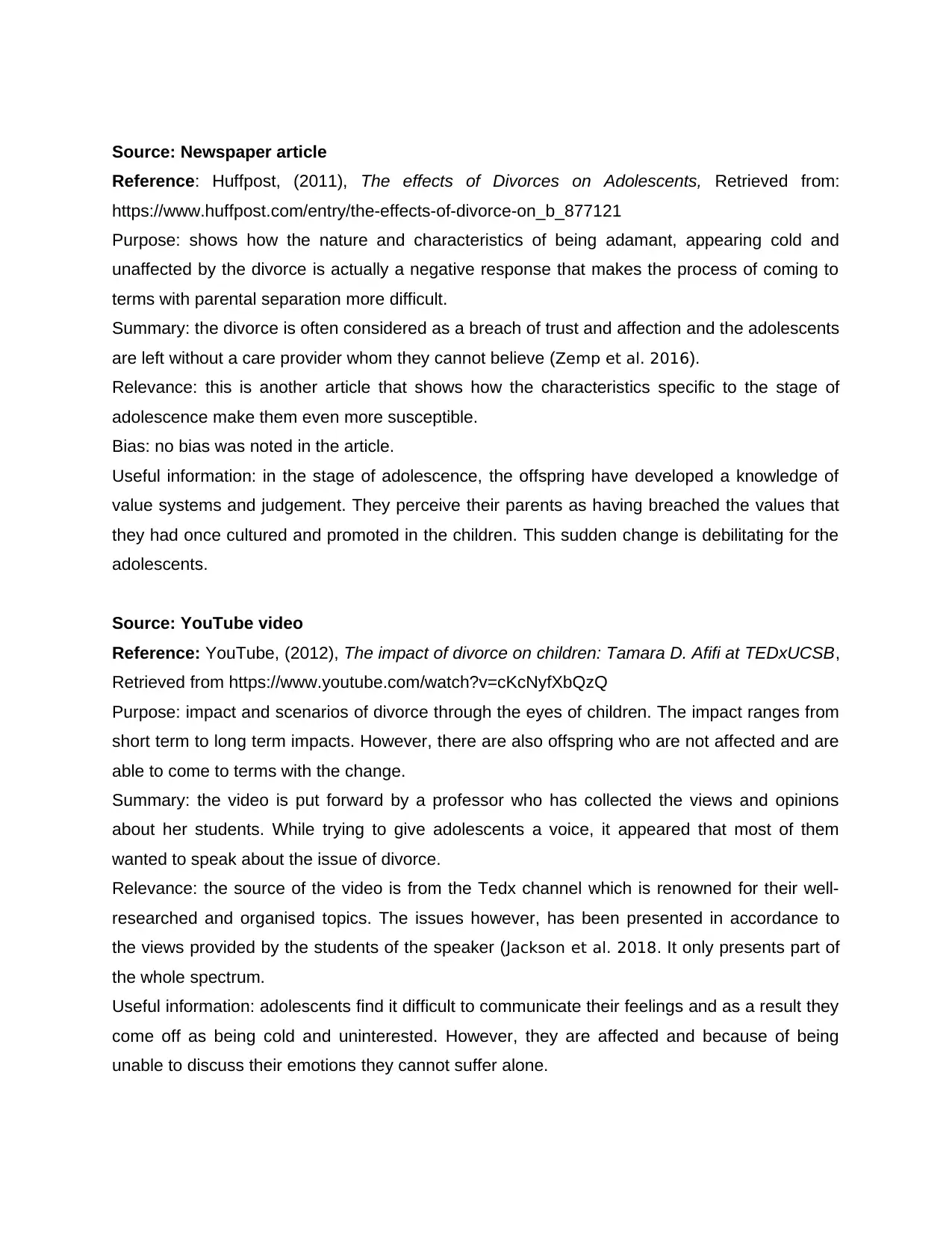
Source: Newspaper article
Reference: Huffpost, (2011), The effects of Divorces on Adolescents, Retrieved from:
https://www.huffpost.com/entry/the-effects-of-divorce-on_b_877121
Purpose: shows how the nature and characteristics of being adamant, appearing cold and
unaffected by the divorce is actually a negative response that makes the process of coming to
terms with parental separation more difficult.
Summary: the divorce is often considered as a breach of trust and affection and the adolescents
are left without a care provider whom they cannot believe (Zemp et al. 2016).
Relevance: this is another article that shows how the characteristics specific to the stage of
adolescence make them even more susceptible.
Bias: no bias was noted in the article.
Useful information: in the stage of adolescence, the offspring have developed a knowledge of
value systems and judgement. They perceive their parents as having breached the values that
they had once cultured and promoted in the children. This sudden change is debilitating for the
adolescents.
Source: YouTube video
Reference: YouTube, (2012), The impact of divorce on children: Tamara D. Afifi at TEDxUCSB,
Retrieved from https://www.youtube.com/watch?v=cKcNyfXbQzQ
Purpose: impact and scenarios of divorce through the eyes of children. The impact ranges from
short term to long term impacts. However, there are also offspring who are not affected and are
able to come to terms with the change.
Summary: the video is put forward by a professor who has collected the views and opinions
about her students. While trying to give adolescents a voice, it appeared that most of them
wanted to speak about the issue of divorce.
Relevance: the source of the video is from the Tedx channel which is renowned for their well-
researched and organised topics. The issues however, has been presented in accordance to
the views provided by the students of the speaker (Jackson et al. 2018. It only presents part of
the whole spectrum.
Useful information: adolescents find it difficult to communicate their feelings and as a result they
come off as being cold and uninterested. However, they are affected and because of being
unable to discuss their emotions they cannot suffer alone.
Reference: Huffpost, (2011), The effects of Divorces on Adolescents, Retrieved from:
https://www.huffpost.com/entry/the-effects-of-divorce-on_b_877121
Purpose: shows how the nature and characteristics of being adamant, appearing cold and
unaffected by the divorce is actually a negative response that makes the process of coming to
terms with parental separation more difficult.
Summary: the divorce is often considered as a breach of trust and affection and the adolescents
are left without a care provider whom they cannot believe (Zemp et al. 2016).
Relevance: this is another article that shows how the characteristics specific to the stage of
adolescence make them even more susceptible.
Bias: no bias was noted in the article.
Useful information: in the stage of adolescence, the offspring have developed a knowledge of
value systems and judgement. They perceive their parents as having breached the values that
they had once cultured and promoted in the children. This sudden change is debilitating for the
adolescents.
Source: YouTube video
Reference: YouTube, (2012), The impact of divorce on children: Tamara D. Afifi at TEDxUCSB,
Retrieved from https://www.youtube.com/watch?v=cKcNyfXbQzQ
Purpose: impact and scenarios of divorce through the eyes of children. The impact ranges from
short term to long term impacts. However, there are also offspring who are not affected and are
able to come to terms with the change.
Summary: the video is put forward by a professor who has collected the views and opinions
about her students. While trying to give adolescents a voice, it appeared that most of them
wanted to speak about the issue of divorce.
Relevance: the source of the video is from the Tedx channel which is renowned for their well-
researched and organised topics. The issues however, has been presented in accordance to
the views provided by the students of the speaker (Jackson et al. 2018. It only presents part of
the whole spectrum.
Useful information: adolescents find it difficult to communicate their feelings and as a result they
come off as being cold and uninterested. However, they are affected and because of being
unable to discuss their emotions they cannot suffer alone.
Paraphrase This Document
Need a fresh take? Get an instant paraphrase of this document with our AI Paraphraser
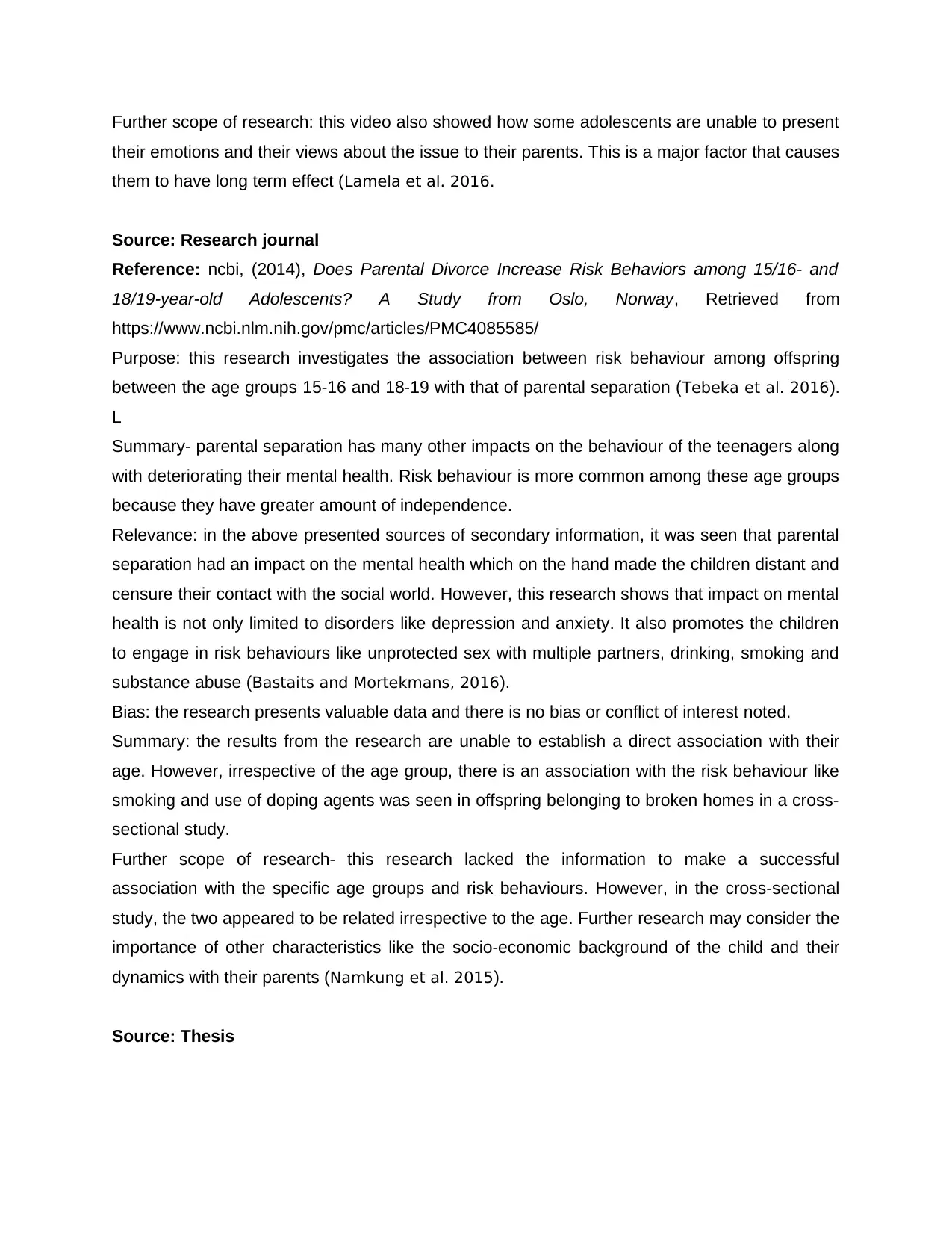
Further scope of research: this video also showed how some adolescents are unable to present
their emotions and their views about the issue to their parents. This is a major factor that causes
them to have long term effect (Lamela et al. 2016.
Source: Research journal
Reference: ncbi, (2014), Does Parental Divorce Increase Risk Behaviors among 15/16- and
18/19-year-old Adolescents? A Study from Oslo, Norway, Retrieved from
https://www.ncbi.nlm.nih.gov/pmc/articles/PMC4085585/
Purpose: this research investigates the association between risk behaviour among offspring
between the age groups 15-16 and 18-19 with that of parental separation (Tebeka et al. 2016).
L
Summary- parental separation has many other impacts on the behaviour of the teenagers along
with deteriorating their mental health. Risk behaviour is more common among these age groups
because they have greater amount of independence.
Relevance: in the above presented sources of secondary information, it was seen that parental
separation had an impact on the mental health which on the hand made the children distant and
censure their contact with the social world. However, this research shows that impact on mental
health is not only limited to disorders like depression and anxiety. It also promotes the children
to engage in risk behaviours like unprotected sex with multiple partners, drinking, smoking and
substance abuse (Bastaits and Mortekmans, 2016).
Bias: the research presents valuable data and there is no bias or conflict of interest noted.
Summary: the results from the research are unable to establish a direct association with their
age. However, irrespective of the age group, there is an association with the risk behaviour like
smoking and use of doping agents was seen in offspring belonging to broken homes in a cross-
sectional study.
Further scope of research- this research lacked the information to make a successful
association with the specific age groups and risk behaviours. However, in the cross-sectional
study, the two appeared to be related irrespective to the age. Further research may consider the
importance of other characteristics like the socio-economic background of the child and their
dynamics with their parents (Namkung et al. 2015).
Source: Thesis
their emotions and their views about the issue to their parents. This is a major factor that causes
them to have long term effect (Lamela et al. 2016.
Source: Research journal
Reference: ncbi, (2014), Does Parental Divorce Increase Risk Behaviors among 15/16- and
18/19-year-old Adolescents? A Study from Oslo, Norway, Retrieved from
https://www.ncbi.nlm.nih.gov/pmc/articles/PMC4085585/
Purpose: this research investigates the association between risk behaviour among offspring
between the age groups 15-16 and 18-19 with that of parental separation (Tebeka et al. 2016).
L
Summary- parental separation has many other impacts on the behaviour of the teenagers along
with deteriorating their mental health. Risk behaviour is more common among these age groups
because they have greater amount of independence.
Relevance: in the above presented sources of secondary information, it was seen that parental
separation had an impact on the mental health which on the hand made the children distant and
censure their contact with the social world. However, this research shows that impact on mental
health is not only limited to disorders like depression and anxiety. It also promotes the children
to engage in risk behaviours like unprotected sex with multiple partners, drinking, smoking and
substance abuse (Bastaits and Mortekmans, 2016).
Bias: the research presents valuable data and there is no bias or conflict of interest noted.
Summary: the results from the research are unable to establish a direct association with their
age. However, irrespective of the age group, there is an association with the risk behaviour like
smoking and use of doping agents was seen in offspring belonging to broken homes in a cross-
sectional study.
Further scope of research- this research lacked the information to make a successful
association with the specific age groups and risk behaviours. However, in the cross-sectional
study, the two appeared to be related irrespective to the age. Further research may consider the
importance of other characteristics like the socio-economic background of the child and their
dynamics with their parents (Namkung et al. 2015).
Source: Thesis
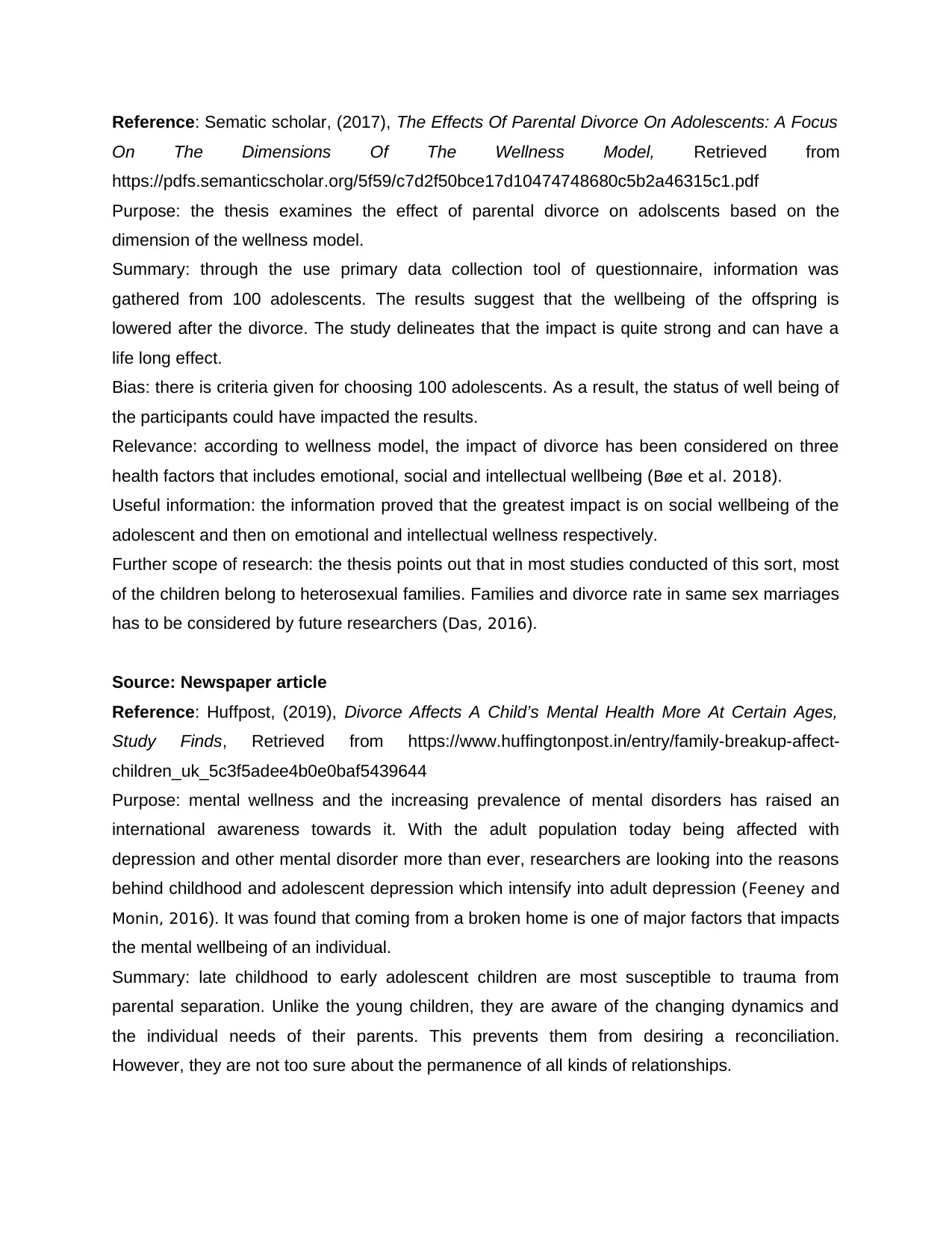
Reference: Sematic scholar, (2017), The Effects Of Parental Divorce On Adolescents: A Focus
On The Dimensions Of The Wellness Model, Retrieved from
https://pdfs.semanticscholar.org/5f59/c7d2f50bce17d10474748680c5b2a46315c1.pdf
Purpose: the thesis examines the effect of parental divorce on adolscents based on the
dimension of the wellness model.
Summary: through the use primary data collection tool of questionnaire, information was
gathered from 100 adolescents. The results suggest that the wellbeing of the offspring is
lowered after the divorce. The study delineates that the impact is quite strong and can have a
life long effect.
Bias: there is criteria given for choosing 100 adolescents. As a result, the status of well being of
the participants could have impacted the results.
Relevance: according to wellness model, the impact of divorce has been considered on three
health factors that includes emotional, social and intellectual wellbeing (Bøe et al. 2018).
Useful information: the information proved that the greatest impact is on social wellbeing of the
adolescent and then on emotional and intellectual wellness respectively.
Further scope of research: the thesis points out that in most studies conducted of this sort, most
of the children belong to heterosexual families. Families and divorce rate in same sex marriages
has to be considered by future researchers (Das, 2016).
Source: Newspaper article
Reference: Huffpost, (2019), Divorce Affects A Child’s Mental Health More At Certain Ages,
Study Finds, Retrieved from https://www.huffingtonpost.in/entry/family-breakup-affect-
children_uk_5c3f5adee4b0e0baf5439644
Purpose: mental wellness and the increasing prevalence of mental disorders has raised an
international awareness towards it. With the adult population today being affected with
depression and other mental disorder more than ever, researchers are looking into the reasons
behind childhood and adolescent depression which intensify into adult depression (Feeney and
Monin, 2016). It was found that coming from a broken home is one of major factors that impacts
the mental wellbeing of an individual.
Summary: late childhood to early adolescent children are most susceptible to trauma from
parental separation. Unlike the young children, they are aware of the changing dynamics and
the individual needs of their parents. This prevents them from desiring a reconciliation.
However, they are not too sure about the permanence of all kinds of relationships.
On The Dimensions Of The Wellness Model, Retrieved from
https://pdfs.semanticscholar.org/5f59/c7d2f50bce17d10474748680c5b2a46315c1.pdf
Purpose: the thesis examines the effect of parental divorce on adolscents based on the
dimension of the wellness model.
Summary: through the use primary data collection tool of questionnaire, information was
gathered from 100 adolescents. The results suggest that the wellbeing of the offspring is
lowered after the divorce. The study delineates that the impact is quite strong and can have a
life long effect.
Bias: there is criteria given for choosing 100 adolescents. As a result, the status of well being of
the participants could have impacted the results.
Relevance: according to wellness model, the impact of divorce has been considered on three
health factors that includes emotional, social and intellectual wellbeing (Bøe et al. 2018).
Useful information: the information proved that the greatest impact is on social wellbeing of the
adolescent and then on emotional and intellectual wellness respectively.
Further scope of research: the thesis points out that in most studies conducted of this sort, most
of the children belong to heterosexual families. Families and divorce rate in same sex marriages
has to be considered by future researchers (Das, 2016).
Source: Newspaper article
Reference: Huffpost, (2019), Divorce Affects A Child’s Mental Health More At Certain Ages,
Study Finds, Retrieved from https://www.huffingtonpost.in/entry/family-breakup-affect-
children_uk_5c3f5adee4b0e0baf5439644
Purpose: mental wellness and the increasing prevalence of mental disorders has raised an
international awareness towards it. With the adult population today being affected with
depression and other mental disorder more than ever, researchers are looking into the reasons
behind childhood and adolescent depression which intensify into adult depression (Feeney and
Monin, 2016). It was found that coming from a broken home is one of major factors that impacts
the mental wellbeing of an individual.
Summary: late childhood to early adolescent children are most susceptible to trauma from
parental separation. Unlike the young children, they are aware of the changing dynamics and
the individual needs of their parents. This prevents them from desiring a reconciliation.
However, they are not too sure about the permanence of all kinds of relationships.
⊘ This is a preview!⊘
Do you want full access?
Subscribe today to unlock all pages.

Trusted by 1+ million students worldwide
1 out of 31
Related Documents
Your All-in-One AI-Powered Toolkit for Academic Success.
+13062052269
info@desklib.com
Available 24*7 on WhatsApp / Email
![[object Object]](/_next/static/media/star-bottom.7253800d.svg)
Unlock your academic potential
Copyright © 2020–2025 A2Z Services. All Rights Reserved. Developed and managed by ZUCOL.





